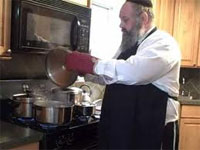
Healthy food choices and dieting are 21st century buzzwords. It seems that more than ever people are making positive dietary changes. For thousands of years, Judaism has offered a dietary blueprint. Not only does the Torah guide us in our food choices, it commands us to separate dairy and meat, and wait a customary length of time between eating meat and dairy dishes. Today, we find Jews of all ages and backgrounds with a growing interest in kashrus and kosher homemaking. For first-hand accounts of people who have kashered their homes click here.
Keeping kosher is not just another diet; it is, in fact, a change in lifestyle. The best place to start is to give away all your non-kosher (treif, in Hebrew) food to your non-Jewish friends. Incidentally, you will be amazed at the number of kosher products that are already stocked on your pantry shelves. With guidance, you can become familiar with the reliable kosher symbols found on tens of thousands of everyday products. Keep in mind that even if mistakes occur once the kitchen is officially kosher, they usually can be readily corrected. Consult a rabbi or layperson who is knowledgeable about kashrus or alternatively, you may e-mail us for specific information and we will be glad to help you.
In order for you to become familiar with the process of kashering your home and know what to expect, it may be helpful to have an overview of the procedures involved. When kashering, the basic principle to bear in mind is based on the Torah’s recognition that materials are porous and can absorb the taste of non-kosher foods. Therefore, the way the non-kosher food was absorbed into the walls of any utensil is the way it is expelled. Hence, a pot used for cooking can be kashered with boiling water; a grill used for roasting can be kashered by direct contact with a heat source that will cause it to glow.
Generally there are two times a person may choose to kasher their home. The first is when they decide to keep a kosher home, and the second is when they want to prepare their kosher home for Pesach. The processes are very similar. One who follows the Pesach guidelines for ovens/cooktops, grills, microwaves, metal utensils and stainless steel sinks, will be assured that he has kashered properly for year-round use as well.
We therefore direct you to our Pesach guidelines. We also have available a video guide to kashering your home for year-round use at our site www.kosherclasses.org
Should you have any questions at all, feel free to contact us at 410-484-4110 or send us an email.
MIKVAH
After kashering, a Jew must immerse his metal and glass utensils in a Mikvah, if it was not done after purchasing. For details, see “The Mitzvah of Tevilas Keilim.”

 STAR-D
STAR-D STAR-S
STAR-S